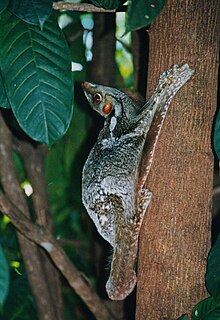Galeopterus variegatus
| Sunda flying lemur | |
|---|---|
 |
|
| Galeopterus variegatus | |
| Scientific classification | |
| Kingdom: | Animalia |
| Phylum: | Chordata |
| Class: | Mammalia |
| Order: | Dermoptera |
| Family: | Cynocephalidae |
| Genus: |
Galeopterus Thomas, 1908 |
| Species: | G. variegatus |
| Binomial name | |
|
Galeopterus variegatus (Audebert, 1799) |
|
| Type species | |
|
Galeopitiecus temminckii Waterhouse, 1838 |
|
 |
|
| Sunda flying lemur range | |
The Sunda flying lemur (Galeopterus variegatus), also known as the Malayan flying lemur, Sunda Colugo or Malayan colugo, is a species of colugo. Until recently, it was thought to be one of only two species of flying lemur, the other being the Philippine flying lemur which is found only in the Philippines. The Sunda flying lemur is found throughout Southeast Asia in Indonesia, Thailand, Malaysia, and Singapore.
The Sunda flying lemur is not a lemur and does not fly. Instead, it glides as it leaps among trees. It is strictly arboreal, is active at night, and feeds on soft plant parts such as young leaves, shoots, flowers, and fruits. After a 60-day gestation period, a single offspring is carried on the mother's abdomen held by a large skin membrane. It is a forest-dependent species.
The head-body length of Sunda flying lemur is about 33 to 42 cm (13 to 17 in). Its tail length measures 18 to 27 cm (7.1 to 10.6 in), and its weight is 0.9 to 1.3 kg (2.0 to 2.9 lb).
The Sunda flying lemur is protected by national legislation. In addition to deforestation and loss of habitat, local subsistence hunting poses a serious threat to this animal. Competition with the plantain squirrel (Callosciurus notatus) represents another challenge for this species. More information is needed on population declines, but at present, the rate of the decline is not believed to merit listing in any category lower than Least Concern.
The Sunda flying lemurs' two forms are not morphologically distinct from one another; the large form occurs on the mainland of the Sunda Shelf area and the mainland of Southeast Asia, while the dwarf form occurs in central Laos and some other adjacent islands. The Laos specimen is smaller (about 20%) than the other known mainland population. Despite the large and dwarf forms, four subspecies are known: G. v. variegatus (Java), G. v. temminckii (Sumatra), G. v. borneanus (Borneo), and G. v. peninsulae (Peninsular Malaysia and mainland of Southeast Asia) incorporating on the genetic species concept due to geographic isolation and genetic divergence. Recent molecular and morphological data provide the evidence that the mainland, Javan, and Bornean Sunda flying lemur subspecies may be recognised as three separate species in the genus Galeopterus.
...
Wikipedia

